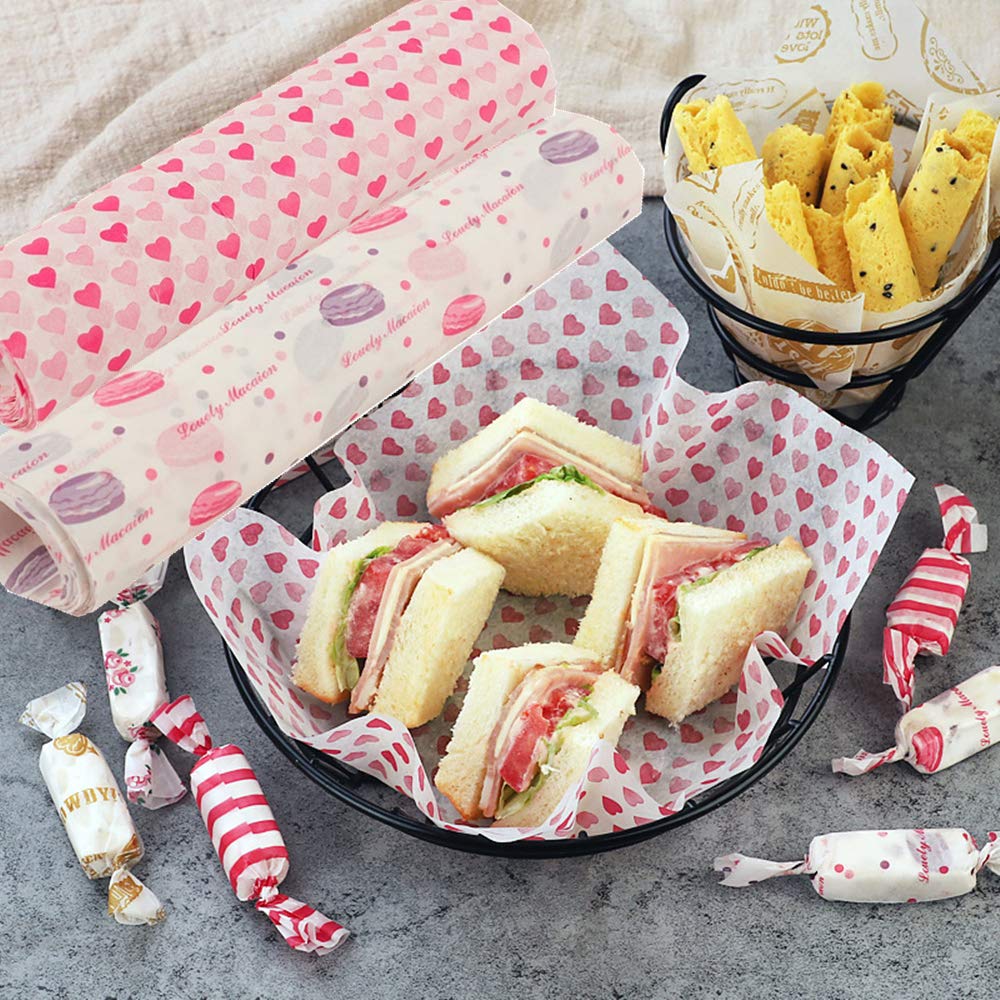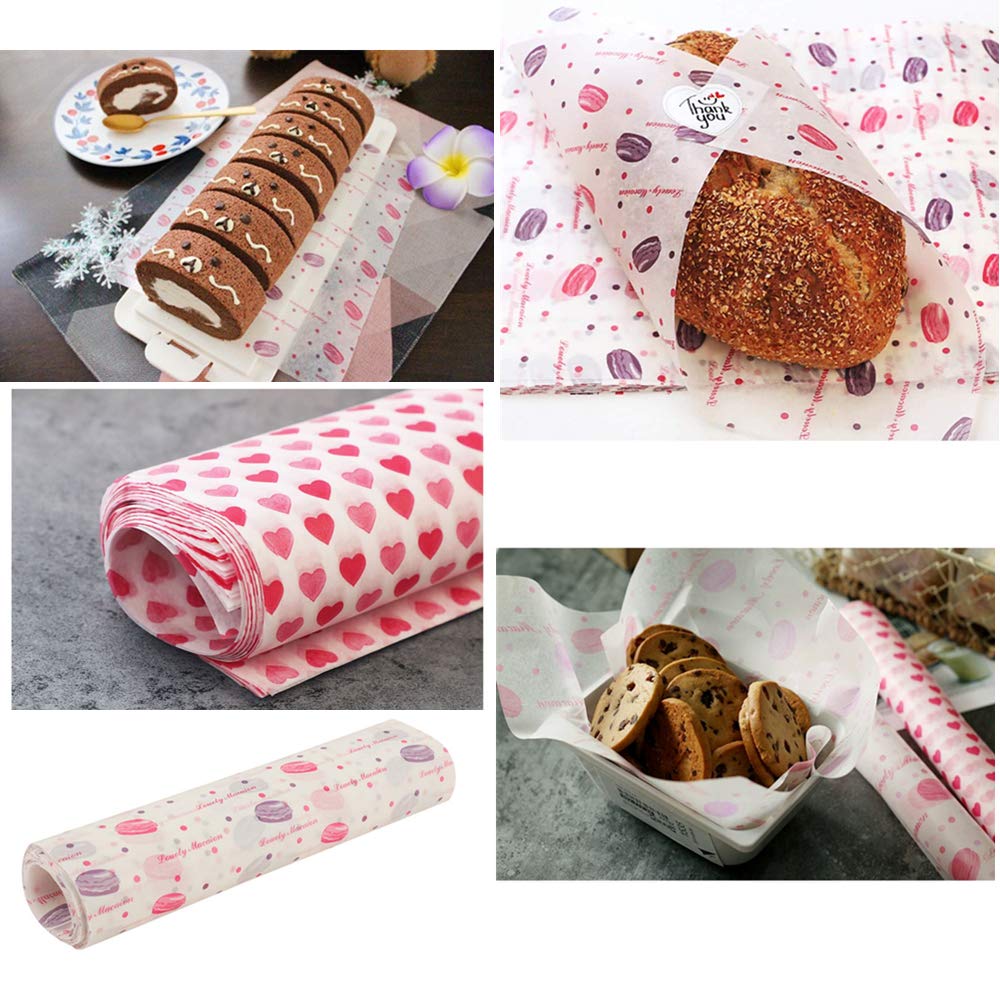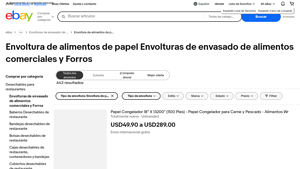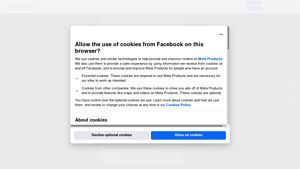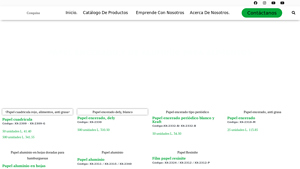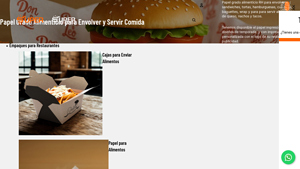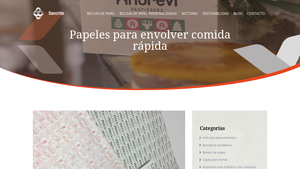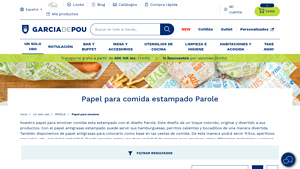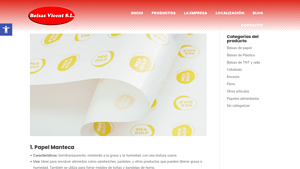Papel Para Envolver Comida: The Ultimate 2025 B2B Sourcing Guide
Introduction: Navigating the Global Market for papel para envolver comida
In the rapidly evolving landscape of food packaging, sourcing the right papel para envolver comida presents a significant challenge for international B2B buyers. The demand for safe, sustainable, and visually appealing food wrapping solutions is on the rise, particularly as businesses seek to enhance brand image while ensuring food safety and compliance with regulations. This comprehensive guide delves into various types of food wrapping paper, including Kraft, paraffin-coated, and eco-friendly options, offering insights into their applications across diverse sectors such as food service, catering, and retail.
Buyers will gain a thorough understanding of how to vet suppliers effectively, assess the cost implications of different materials, and explore customization options that align with their branding strategies. With a focus on regions such as Africa, South America, the Middle East, and Europe, including markets like Vietnam and Saudi Arabia, this guide empowers B2B purchasers to make informed decisions that cater to local preferences while upholding global standards. By equipping stakeholders with actionable insights and expert recommendations, we aim to simplify the procurement process, ultimately supporting the growth and sustainability of businesses in the food industry.
Understanding papel para envolver comida Types and Variations
| Type Name | Key Distinguishing Features | Primary B2B Applications | Brief Pros & Cons for Buyers |
|---|---|---|---|
| Kraft Paper | Thick, durable, writable; available in various weights | Butcheries, bakeries, supermarkets | Pros: Versatile, eco-friendly; Cons: Limited moisture resistance without coating. |
| Wax Paper | Moisture and grease-resistant; ideal for oily foods | Fast food outlets, delis, food trucks | Pros: Excellent moisture barrier; Cons: Not suitable for high-temperature cooking. |
| Hot Melt Paper | Sustainable option with high-quality presentation | Gourmet food businesses, upscale cafes | Pros: Eco-friendly, premium look; Cons: May be pricier than alternatives. |
| Freezer Paper | Coated to prevent freezer burn; suitable for long-term storage | Food processing, catering, meal prep | Pros: Preserves food quality; Cons: Bulk purchasing may be required. |
| Anti-Grease Paper | Specialized for greasy foods; often printed for branding | Restaurants, food trucks, catering services | Pros: Enhances food presentation; Cons: Limited to specific food types. |
What are the Key Characteristics of Kraft Paper for Food Wrapping?
Kraft paper is a robust, thick paper often used in food packaging due to its durability and versatility. It is available in various weights, typically ranging from 80 to 100 grams per square meter. This type of paper is particularly suitable for wrapping meats, baked goods, and other food items that require a sturdy packaging solution. B2B buyers should consider the environmental impact of kraft paper, as it is biodegradable and recyclable, aligning with sustainable practices.
How Does Wax Paper Benefit Fast Food Applications?
Wax paper features a moisture and grease-resistant coating, making it ideal for wrapping oily foods such as fried items and sandwiches. Its ability to maintain food quality while providing an appealing presentation makes it a popular choice among fast food outlets and food trucks. Buyers should focus on sourcing high-quality wax paper to ensure it withstands the demands of a busy food service environment, while also considering custom printing options for branding.
Why Choose Hot Melt Paper for Gourmet Food Packaging?
Hot melt paper is a premium option that offers a sustainable and high-quality presentation. It is often favored by gourmet food businesses and upscale cafes due to its attractive appearance and eco-friendly characteristics. When purchasing, B2B buyers should assess the cost-effectiveness of hot melt paper compared to traditional options, as its price point may be higher, but it provides added value through enhanced customer experience and brand perception.
What Makes Freezer Paper Essential for Food Storage?
Freezer paper is designed with a special coating that prevents freezer burn, making it an essential choice for food processors and catering services. It allows for long-term storage of meats and prepared meals without compromising quality. B2B buyers should consider bulk purchasing options to optimize costs, as this type of paper is often sold in larger quantities to accommodate food service needs.
How Can Anti-Grease Paper Enhance Food Presentation?
Anti-grease paper is specifically designed to handle greasy foods, often featuring prints that enhance branding and presentation. This type of paper is widely used in restaurants and catering services, particularly for items like burgers and fried foods. When sourcing anti-grease paper, buyers should look for options that balance functionality with aesthetic appeal, ensuring that it meets both practical and marketing needs.
Key Industrial Applications of papel para envolver comida
| Industry/Sector | Specific Application of papel para envolver comida | Value/Benefit for the Business | Key Sourcing Considerations for this Application |
|---|---|---|---|
| Food Service & Catering | Custom-branded wrapping for sandwiches and fast food items | Enhances brand visibility and customer experience | Compliance with food safety regulations and customization options |
| Retail & Grocery | Packaging for meat, fish, and bakery products | Preserves freshness and prevents contamination | Material durability and moisture resistance |
| Food Processing | Wrapping for frozen and prepared foods | Extends shelf life and maintains quality | Compatibility with freezing processes and barrier properties |
| Street Food & Takeaway | Eco-friendly paper for wrapping street food items | Appeals to environmentally conscious consumers | Sourcing sustainable materials and food-grade certifications |
| Catering & Events | Decorative paper for food presentation | Enhances aesthetic appeal and customer satisfaction | Availability of various designs and sizes for different occasions |
How is ‘papel para envolver comida’ Used in the Food Service & Catering Industry?
In the food service and catering industry, custom-branded wrapping paper is used for sandwiches, burgers, and other fast food items. This application not only enhances the visual appeal of the food but also reinforces brand identity, helping businesses stand out in a competitive market. Buyers should ensure that the paper meets food safety standards and is available in customizable options to reflect their branding effectively.
What Role Does ‘papel para envolver comida’ Play in Retail & Grocery?
Retail and grocery sectors utilize specialized wrapping papers for meat, fish, and bakery products. These papers help preserve the freshness of the food while preventing contamination. For international buyers, sourcing durable materials that comply with local food safety regulations is crucial, as well as ensuring that the paper is suitable for refrigeration and display purposes.
How Does ‘papel para envolver comida’ Benefit Food Processing?
In food processing, wrapping papers are essential for frozen and prepared foods. They extend shelf life and maintain product quality by providing effective barriers against moisture and air. Buyers in this sector must consider the paper’s compatibility with freezing processes and its ability to retain food integrity during transport and storage.
Why is ‘papel para envolver comida’ Important for Street Food & Takeaway Businesses?
Street food vendors and takeaway businesses increasingly opt for eco-friendly paper to wrap food items. This practice not only caters to the growing demand for sustainable packaging but also enhances the customer experience by providing a more appealing presentation. Sourcing sustainable materials that are food-grade certified is vital for businesses looking to align with consumer preferences for environmentally responsible options.
How is ‘papel para envolver comida’ Used in Catering & Events?
In catering and events, decorative paper is often used for food presentation. This enhances the aesthetic appeal of the offerings, contributing to a memorable dining experience. Buyers should look for a variety of designs and sizes to cater to different occasions, ensuring that the chosen wrapping complements the overall theme and enhances customer satisfaction.
3 Common User Pain Points for ‘papel para envolver comida’ & Their Solutions
Scenario 1: Inconsistent Quality of Food Wrapping Paper
The Problem: B2B buyers often face challenges with the quality of food wrapping paper, which can lead to significant operational issues. For instance, a restaurant owner might purchase a bulk order of wrapping paper that appears sturdy but fails during real-world use, such as tearing easily or not providing adequate moisture resistance. This inconsistency can jeopardize food safety, affect presentation, and ultimately impact customer satisfaction.
The Solution: To mitigate these risks, buyers should prioritize sourcing paper from reputable suppliers who provide product samples for testing before bulk purchases. It’s essential to request specifications regarding the paper’s weight, thickness, and moisture resistance capabilities. Understanding the specific needs of their food offerings—whether it’s wrapping greasy foods or keeping sandwiches fresh—will allow buyers to select the most suitable type of paper, such as greaseproof or wax-coated options. Additionally, establishing a relationship with suppliers who can ensure consistent quality checks and provide certifications for food safety standards will enhance reliability in sourcing.
Scenario 2: Environmental Sustainability Concerns
The Problem: As global awareness of environmental issues rises, many businesses face pressure to adopt sustainable practices. For a catering company or food service provider, choosing the right food wrapping materials can be daunting, especially when balancing functionality with eco-friendliness. Buyers may struggle with finding compostable or recyclable wrapping options that don’t compromise on performance, leading to potential backlash from environmentally conscious consumers.
The Solution: Buyers should actively seek out suppliers who specialize in sustainable food wrapping solutions. This includes researching biodegradable papers, such as those made from recycled materials or natural fibers. It’s beneficial to request detailed information on the sourcing practices and certifications of these products, ensuring they meet both environmental standards and food safety regulations. Additionally, buyers can explore options for custom branding on eco-friendly wrappers, which not only reinforces their commitment to sustainability but also enhances their marketing efforts. By integrating sustainable materials into their operations, businesses can appeal to a growing segment of eco-conscious customers.
Scenario 3: Customization and Branding Limitations
The Problem: In the competitive food service market, branding is crucial, yet many B2B buyers find that standard food wrapping paper options offer little room for customization. A food truck owner, for example, may struggle to find wrapping materials that reflect their unique brand identity, which can hinder their marketing efforts and customer engagement. The inability to incorporate logos or specific designs can lead to missed opportunities for brand recognition and loyalty.
The Solution: Buyers should partner with suppliers who offer customizable food wrapping solutions. This includes the ability to print logos, brand colors, and unique designs on the paper, which can significantly enhance a business’s visibility. When discussing options with suppliers, it’s important to inquire about minimum order quantities for customization, as well as turnaround times. Additionally, exploring various types of papers that can accommodate printing—such as kraft paper or parchment—can provide more aesthetically pleasing and functional wrapping solutions. Implementing customized wrappers can create a memorable experience for customers, fostering brand loyalty and differentiation in a crowded market.
Strategic Material Selection Guide for papel para envolver comida
What Are the Key Properties of Common Materials Used for Food Wrapping Paper?
When selecting materials for food wrapping paper, it is essential to consider their properties, performance, and suitability for different applications. Here are four common materials used in the industry:
1. Kraft Paper
Kraft paper, often referred to as butcher paper, is a robust and versatile option for wrapping food. It is known for its strength and ability to be printed on, making it suitable for branding purposes. Kraft paper typically comes in weights of 80 to 100 g/m², offering good durability.
Pros & Cons: Kraft paper is biodegradable and recyclable, making it an environmentally friendly choice. However, it may not provide sufficient moisture or grease resistance unless treated. Its cost is generally low to medium, depending on the treatment and customization.
Impact on Application: This material is ideal for wrapping meats, sandwiches, and bakery items. However, it may not be suitable for items with high moisture content without additional coatings.
Considerations for International Buyers: Kraft paper must comply with food safety standards, such as those outlined by the FDA or EU regulations. Buyers should look for certifications that confirm the paper is food-grade.
2. Wax Paper
Wax paper is coated with a thin layer of wax, providing excellent moisture resistance. This makes it an ideal choice for wrapping greasy or moist foods.
Pros & Cons: The primary advantage of wax paper is its ability to keep food fresh by preventing moisture loss. However, it is not suitable for high-temperature applications, as the wax can melt. The cost is typically low.
Impact on Application: Wax paper is often used in delis and for wrapping baked goods. Its limitations in heat resistance mean it should not be used in ovens or microwaves.
Considerations for International Buyers: Buyers should ensure that wax paper meets local food safety standards, as regulations may vary by region. Compliance with ASTM or similar standards is crucial.
3. Parafined Paper
Parafined paper is treated with paraffin wax, making it highly resistant to moisture and grease. This material is particularly effective for wrapping meats and oily foods.
Pros & Cons: Parafined paper offers superior moisture retention, which helps maintain the quality of the wrapped food. However, it is less environmentally friendly due to the petrochemical content. The cost is generally medium.
Impact on Application: This paper is ideal for food items that release moisture, such as fish and meats. However, it may not be suitable for high-temperature cooking.
Considerations for International Buyers: Compliance with food safety regulations is essential, especially in regions with strict packaging laws. Buyers should verify that the parafined paper meets relevant international standards.
4. Hot Melt Coated Paper
Hot melt coated paper is a sustainable option that uses a hot melt adhesive for moisture resistance. It is gaining popularity among environmentally conscious businesses.
Pros & Cons: This paper is biodegradable and provides a high-quality presentation, making it suitable for gourmet food items. However, it may be more expensive than traditional options, which could deter cost-sensitive buyers.
Impact on Application: Hot melt coated paper is perfect for high-end restaurants and food trucks that want to enhance their branding. Its moisture resistance makes it versatile for various food types.
Considerations for International Buyers: Buyers should look for certifications that confirm the sustainability of the materials used. Compliance with international standards such as ISO or DIN can also be a deciding factor.
Summary Table of Material Selection for Food Wrapping Paper
| Material | Typical Use Case for papel para envolver comida | Key Advantage | Key Disadvantage/Limitation | Relative Cost (Low/Med/High) |
|---|---|---|---|---|
| Kraft Paper | Wrapping meats, sandwiches, bakery items | Biodegradable and recyclable | Limited moisture resistance | Low |
| Wax Paper | Wrapping greasy or moist foods | Excellent moisture resistance | Not heat-resistant | Low |
| Parafined Paper | Wrapping meats and oily foods | Superior moisture retention | Less environmentally friendly | Med |
| Hot Melt Coated Paper | Gourmet food items, high-end restaurants | Sustainable and high-quality presentation | Higher cost compared to traditional options | High |
This guide assists B2B buyers in making informed decisions regarding material selection for food wrapping paper, ensuring compliance with international standards and meeting specific application needs.
In-depth Look: Manufacturing Processes and Quality Assurance for papel para envolver comida
What Are the Main Stages in the Manufacturing Process of Food Wrapping Paper?
The manufacturing process of food wrapping paper, or “papel para envolver comida,” involves several critical stages, each designed to ensure the final product meets safety, quality, and functional requirements. These stages typically include material preparation, forming, assembly, and finishing.
-
Material Preparation: The primary materials used in food wrapping paper include paper pulp, wax, polyethylene, and other additives. The process begins with sourcing high-quality raw materials. This may involve rigorous testing to ensure that the materials are food-safe and compliant with international standards. For example, Kraft paper is often chosen for its strength, while paraffin or polyethylene may be added for moisture resistance.
-
Forming: In this stage, the prepared materials are transformed into sheets or rolls. This involves several techniques such as pulping, pressing, and drying. The paper is formed into the desired thickness and texture, which is crucial for its performance in wrapping various food products. Specialized machinery, such as paper machines, is employed to achieve consistent quality across large volumes.
-
Assembly: Once the paper sheets or rolls are formed, they may undergo additional processing. This can include coating with paraffin or polyethylene for added moisture resistance, printing with food-safe inks, or cutting into specific sizes. This stage often involves customization options, allowing B2B buyers to order branded or uniquely designed wrapping paper for their products.
-
Finishing: The final stage involves inspecting the product for quality and consistency. This may include applying finishes that enhance the paper’s appearance and functionality, such as gloss or matte coatings. Additionally, packaging the finished rolls or sheets for distribution is an essential part of this stage to ensure they remain undamaged during transport.
How Does Quality Assurance Work in the Production of Food Wrapping Paper?
Quality assurance (QA) is a critical aspect of the manufacturing process for food wrapping paper, ensuring that products are safe for food contact and meet customer expectations. Various international and industry-specific standards guide these processes.
-
Relevant International Standards: Adhering to standards like ISO 9001 is essential for manufacturers. This standard outlines the criteria for a quality management system, focusing on consistent quality and customer satisfaction. Other relevant certifications include CE marking for compliance with European health, safety, and environmental protection standards and food safety certifications like FSSC 22000.
-
Quality Control Checkpoints: Quality control (QC) checkpoints are integrated throughout the manufacturing process. Key checkpoints include:
– Incoming Quality Control (IQC): Inspecting raw materials upon receipt to ensure they meet specified standards.
– In-Process Quality Control (IPQC): Monitoring the production process at various stages to detect any deviations from quality standards.
– Final Quality Control (FQC): Conducting a thorough inspection of the finished product before packaging and shipment. -
Common Testing Methods: Various testing methods are employed to ensure that the wrapping paper meets safety and quality standards. These methods may include:
– Physical testing: Assessing tensile strength, tear resistance, and moisture barrier properties.
– Chemical testing: Ensuring that the materials do not leach harmful substances into food.
– Microbiological testing: Evaluating the paper for microbial contamination, which is crucial for food safety.
How Can B2B Buyers Verify Supplier Quality Control Processes?
For international B2B buyers, especially those from regions like Africa, South America, the Middle East, and Europe, verifying the QC processes of suppliers is vital to ensure product quality and safety. Here are several strategies to effectively assess supplier QC:
-
Conduct Audits: Regularly scheduled audits of the manufacturing facilities can provide insight into the supplier’s adherence to quality standards. Buyers can assess production practices, QC checkpoints, and overall compliance with international standards during these audits.
-
Request Quality Reports: Suppliers should provide documented evidence of their quality control processes, including results from IQC, IPQC, and FQC. These reports can help buyers understand how the supplier manages quality throughout the production cycle.
-
Engage Third-Party Inspections: Utilizing third-party inspection services can add an additional layer of assurance. These independent entities can perform unannounced inspections and testing to verify that the supplier is maintaining the necessary standards.
-
Understand QC/CERT Nuances for International Markets: Different regions may have varying regulations and standards for food contact materials. Buyers should be aware of local requirements and ensure that their suppliers comply with both international and regional standards. This is particularly important when sourcing from countries like Vietnam or Saudi Arabia, where specific regulations may apply.
What Are the Key Considerations for Sourcing Food Wrapping Paper Globally?
When sourcing food wrapping paper on an international scale, B2B buyers should consider several factors beyond just price and availability:
-
Supplier Reputation and Experience: Researching the supplier’s history, reputation, and experience in the industry can provide insights into their ability to deliver quality products consistently.
-
Customization Options: Many businesses seek customized solutions that align with their branding. Understanding a supplier’s capacity for customization can be a significant factor in the decision-making process.
-
Sustainability Practices: With growing emphasis on environmental responsibility, buyers should inquire about the sustainability practices of their suppliers. This includes the sourcing of raw materials, production methods, and waste management practices.
-
Lead Times and Logistics: Effective supply chain management is crucial for timely delivery. Buyers should clarify lead times, shipping options, and potential delays to ensure smooth operations.
By thoroughly understanding the manufacturing processes and quality assurance protocols involved in the production of food wrapping paper, B2B buyers can make informed decisions that align with their business needs and ensure the safety and quality of their food products.
Practical Sourcing Guide: A Step-by-Step Checklist for ‘papel para envolver comida’
In the competitive landscape of food packaging, particularly for ‘papel para envolver comida’, sourcing the right materials is essential for maintaining food safety, enhancing brand image, and meeting consumer demands. This guide provides a practical checklist for B2B buyers looking to procure food wrapping paper effectively and efficiently.
Step 1: Define Your Technical Specifications
Begin by clearly outlining the specifications required for your food wrapping paper. Consider factors such as material type (Kraft, paraffined, or hot melt), thickness, and food compatibility. Each type of paper serves different purposes, such as moisture retention or grease resistance, so understanding the specific needs of your products is crucial for making an informed choice.
Step 2: Research Regulatory Compliance
Ensure that the food wrapping paper complies with international food safety regulations. Different regions may have specific certifications for food-grade materials, such as FDA approval in the USA or EU standards in Europe. Verify that your suppliers can provide documentation proving their products meet these safety standards to avoid potential liabilities.
Step 3: Evaluate Potential Suppliers
Thoroughly vet potential suppliers to assess their reliability and quality. Request detailed company profiles, certifications, and case studies relevant to your industry. Look for reviews or references from other B2B buyers to ensure their products have a history of performance and compliance.
- Considerations:
- Supplier experience in the food packaging industry.
- Their ability to handle bulk orders and customizations.
Step 4: Assess Material Quality and Performance
Request samples of the wrapping paper to evaluate its quality firsthand. Consider how well the paper performs in terms of durability, moisture retention, and grease resistance. Testing the paper with actual food products will help ascertain whether it meets your operational needs and customer expectations.
Step 5: Understand Customization Options
Customization can enhance your brand’s visibility and appeal. Inquire about options for printing logos, designs, or specific dimensions that cater to your products. Custom packaging can significantly impact customer experience and brand recognition, making it a worthwhile investment.
Step 6: Negotiate Pricing and Terms
Once you have selected potential suppliers, initiate discussions on pricing, payment terms, and delivery schedules. Understanding the cost structure is vital for budgeting and forecasting. Ensure that you factor in all potential costs, including shipping and any additional fees for customization.
Step 7: Finalize Contracts and Monitor Supply Chain
After agreeing on terms, finalize contracts with clear deliverables and timelines. Establish a system for monitoring your supply chain to ensure consistent quality and timely deliveries. Regular communication with your suppliers will help address any issues promptly and maintain a strong partnership.
By following this checklist, B2B buyers can streamline the procurement process for food wrapping paper, ensuring that they select the right materials that align with their business needs while upholding quality and safety standards.
Comprehensive Cost and Pricing Analysis for papel para envolver comida Sourcing
What Are the Key Cost Components in Sourcing ‘papel para envolver comida’?
When analyzing the cost structure for sourcing ‘papel para envolver comida’, several components come into play. The primary cost elements include:
-
Materials: The choice of paper significantly impacts costs. Options like Kraft paper, paraffin-coated paper, and aluminum foil vary in price due to their raw material costs. Specialty papers, such as those with eco-friendly coatings, can also be more expensive.
-
Labor: Labor costs are incurred during the manufacturing process, which can vary based on the location of production. Regions with lower labor costs may offer competitive pricing, but this must be balanced against quality control and production efficiency.
-
Manufacturing Overhead: This includes expenses related to utilities, rent, equipment maintenance, and other operational costs necessary to keep production running smoothly. High overhead can lead to increased pricing.
-
Tooling: For custom paper products, tooling costs for dies and molds can add to the initial investment. The complexity of the design will influence the tooling expense, which is particularly relevant for businesses looking to differentiate their products with unique branding.
-
Quality Control (QC): Ensuring compliance with food safety standards requires rigorous QC processes, which can add to the overall costs. This is especially important for international buyers who must adhere to different regulatory standards.
-
Logistics: Shipping costs, including freight, insurance, and potential tariffs, play a significant role in the final pricing. Buyers should consider the distance from the supplier and the chosen Incoterms, as these factors can greatly influence logistics costs.
-
Margin: Suppliers will factor in their desired profit margins, which can vary widely based on market conditions, competition, and perceived value of the product.
How Do Price Influencers Impact Sourcing ‘papel para envolver comida’?
Several factors can influence the pricing of ‘papel para envolver comida’:
-
Volume/MOQ: Purchasing in larger quantities often leads to lower per-unit costs. Buyers should negotiate minimum order quantities (MOQs) that suit their needs while maximizing cost efficiency.
-
Specifications and Customization: Custom designs or specific material requirements can lead to higher costs. Buyers should evaluate whether the added expense of customization aligns with their branding strategy and target market.
-
Material Quality and Certifications: Higher quality materials often come with a higher price tag. Additionally, certifications for food safety and environmental compliance can affect costs, particularly for buyers in regulated markets.
-
Supplier Factors: The reputation and reliability of suppliers can influence pricing. Established suppliers with a history of quality may charge more, but they often provide better service and consistency.
-
Incoterms: The chosen Incoterms can affect costs significantly. Understanding responsibilities for shipping, insurance, and customs can help buyers avoid unexpected expenses.
What Tips Can Help B2B Buyers Negotiate Better Prices for ‘papel para envolver comida’?
For international B2B buyers, especially those in Africa, South America, the Middle East, and Europe, negotiating effectively can lead to substantial savings:
-
Understand Total Cost of Ownership (TCO): Consider not just the purchase price but all associated costs, including logistics, storage, and potential wastage. This comprehensive view can provide leverage in negotiations.
-
Research Market Prices: Understanding the typical market rates for different types of wrapping paper can provide a benchmark for negotiations.
-
Build Relationships with Suppliers: Establishing a rapport with suppliers can lead to better terms and pricing flexibility. Long-term relationships often result in better deals.
-
Leverage Local and Regional Suppliers: Sourcing from local or regional suppliers can reduce shipping costs and lead times, enhancing overall supply chain efficiency.
-
Be Transparent About Needs: Clearly communicate your requirements and constraints to suppliers. This transparency can foster trust and lead to more favorable terms.
Disclaimer on Indicative Prices
Pricing for ‘papel para envolver comida’ can vary widely based on the factors outlined above. Buyers should conduct thorough market research and engage with multiple suppliers to obtain accurate and competitive pricing tailored to their specific needs.
Alternatives Analysis: Comparing papel para envolver comida With Other Solutions
Exploring Alternatives to ‘Papel Para Envolver Comida’
In the food packaging industry, businesses often seek effective solutions for wrapping and preserving food items. While ‘papel para envolver comida’ is a popular choice, it is essential to consider alternative methods and materials that might better suit specific operational needs. Below is a comparison of ‘papel para envolver comida’ with two viable alternatives: aluminum foil and biodegradable food wraps.
| Comparison Aspect | Papel Para Envolver Comida | Aluminum Foil | Biodegradable Food Wraps |
|---|---|---|---|
| Performance | Excellent moisture and grease barrier; customizable designs | Superior insulation and protection; retains heat well | Good moisture protection; compostable options available |
| Cost | Moderate, varies by type and customization | Generally low-cost, widely available | Higher initial cost, but potential savings in waste management |
| Ease of Implementation | Simple to use; requires no special equipment | Very easy to use; versatile for various applications | Slightly more complex; may require user education |
| Maintenance | No maintenance; disposable | Disposable, no cleanup required | Requires proper disposal; some may be reusable |
| Best Use Case | Ideal for restaurants and takeaways; branding potential | Best for home use and food preservation; efficient for cooking | Suitable for eco-conscious businesses and organic food markets |
In-Depth Analysis of Alternatives
Aluminum Foil
Aluminum foil is a longstanding staple in food packaging. Its superior insulation properties allow it to keep food warm, making it an excellent choice for catering and takeout services. However, it lacks the branding capabilities of ‘papel para envolver comida’ and can be less appealing for presentation purposes. While its cost is generally low, the environmental impact of aluminum production and disposal can be a concern for eco-conscious businesses.
Biodegradable Food Wraps
Biodegradable food wraps represent a growing trend towards sustainability in food packaging. Made from natural materials, these wraps are compostable and offer a viable alternative for businesses aiming to reduce their carbon footprint. They provide good moisture protection but may not be as effective as traditional paper or aluminum in preserving food freshness for extended periods. The initial cost can be higher than conventional options, but they may yield savings in waste management and appeal to environmentally aware consumers.
Making the Right Choice for Your Business Needs
When selecting the right food wrapping solution, B2B buyers should consider their specific operational needs, target market, and branding strategies. ‘Papel para envolver comida’ is particularly effective for businesses focusing on presentation and customization, while aluminum foil is best suited for practical applications that prioritize insulation. For businesses committed to sustainability, biodegradable wraps may align better with their values, despite a higher upfront investment. Ultimately, the choice should reflect the business’s operational goals, customer preferences, and commitment to environmental responsibility.
Essential Technical Properties and Trade Terminology for papel para envolver comida
What Are the Essential Technical Properties of ‘papel para envolver comida’?
When selecting paper for food wrapping, several critical technical properties must be considered to ensure food safety, quality, and customer satisfaction. Here are key specifications that B2B buyers should focus on:
-
Material Grade: The material grade refers to the quality of the paper used, often categorized as food-safe or food-grade. This specification is crucial because it ensures that the paper will not leach harmful substances into the food, which is essential for compliance with health regulations. Products like Kraft paper, paraffin-coated paper, and waxed paper are commonly used due to their durability and food safety.
-
Basis Weight (Grams per Square Meter – GSM): This measurement indicates the weight of the paper per square meter and is essential for determining the thickness and sturdiness of the wrapping material. For example, Kraft paper typically ranges from 80 to 100 GSM, making it suitable for heavy items like meats and baked goods. A higher GSM often implies better moisture resistance and durability, which is vital for maintaining the integrity of the wrapped food during transport.
-
Moisture Resistance: This property is critical for food products that have high moisture content, such as meats and fish. Papers with moisture-resistant coatings, like polyethylene or paraffin, prevent water from seeping through, thus extending the shelf life of the food and maintaining its quality. B2B buyers should look for materials that offer effective barriers against moisture and grease.
-
Printability: The ability to print on the wrapping paper is vital for branding and marketing purposes. Customizable options allow businesses to enhance their packaging with logos and designs, creating a unique identity that can attract customers. Materials that allow for high-quality printing while maintaining food safety standards are highly sought after.
-
Biodegradability and Sustainability: With the growing focus on eco-friendly practices, choosing biodegradable or compostable wrapping paper is increasingly important. B2B buyers should inquire about the sustainability of the materials used, as this can impact their brand reputation and compliance with environmental regulations.
-
Temperature Resistance: Understanding how the wrapping material performs under various temperature conditions is essential, especially for items that may be frozen or heated. Papers like oven-safe parchment and freezer-grade Kraft paper can withstand high temperatures without breaking down, making them suitable for a range of culinary applications.
What Trade Terms Are Common in the ‘papel para envolver comida’ Industry?
Navigating the commercial landscape of food wrapping paper involves familiarizing oneself with specific trade terms that are frequently used in the industry. Here are some essential terms that B2B buyers should know:
-
OEM (Original Equipment Manufacturer): This term refers to a company that produces parts or products that may be marketed by another manufacturer. In the context of food wrapping paper, an OEM may supply customized packaging solutions tailored to a client’s specifications.
-
MOQ (Minimum Order Quantity): MOQ indicates the smallest quantity of a product that a supplier is willing to sell. Understanding MOQs is crucial for buyers to gauge inventory management and cost-effectiveness, especially when dealing with specialized food wrapping papers.
-
RFQ (Request for Quotation): An RFQ is a document sent to suppliers to request pricing and terms for specific products. B2B buyers utilize RFQs to compare suppliers’ offerings for food wrapping papers, ensuring they get competitive pricing and favorable terms.
-
Incoterms (International Commercial Terms): These are predefined commercial terms published by the International Chamber of Commerce (ICC) that outline the responsibilities of buyers and sellers in international transactions. Familiarity with Incoterms helps businesses understand shipping costs, risks, and obligations associated with the delivery of food wrapping paper.
-
Sustainability Certification: This refers to third-party certifications that indicate a product meets specific environmental and sustainability standards. Certifications such as FSC (Forest Stewardship Council) or compostable labels assure buyers that their packaging is sourced responsibly.
-
Lead Time: This term refers to the time taken from placing an order to the delivery of the product. Understanding lead times is essential for B2B buyers to plan inventory and ensure that they have adequate supplies of food wrapping paper to meet customer demand.
By comprehensively understanding these technical properties and industry terminology, B2B buyers can make informed decisions when sourcing ‘papel para envolver comida’, ultimately enhancing their product offerings and operational efficiency.
Navigating Market Dynamics and Sourcing Trends in the papel para envolver comida Sector
What Are the Key Market Trends Influencing the papel para envolver comida Sector?
The global market for food wrapping paper, or “papel para envolver comida,” is evolving rapidly, driven by several factors. The surge in food delivery services, coupled with the growing demand for convenience in food consumption, has significantly increased the need for effective food packaging solutions. International B2B buyers, particularly from regions such as Africa, South America, the Middle East, and Europe, are increasingly seeking innovative packaging options that not only preserve food quality but also enhance presentation.
Emerging technologies in the packaging sector, such as biodegradable materials and smart packaging solutions, are reshaping sourcing strategies. For instance, the integration of QR codes in packaging allows businesses to engage customers through digital platforms, enhancing brand visibility and customer experience. Furthermore, customization is becoming a vital trend, as businesses look to differentiate their offerings in a competitive landscape. Personalized packaging solutions, including branded food wrapping paper, are gaining traction as they help businesses strengthen their brand identity.
In response to global health concerns, there is a notable shift towards materials that ensure food safety and compliance with regulatory standards. This trend is particularly relevant for international buyers, who must navigate various regulations across markets. Additionally, the rise of e-commerce has spurred demand for versatile packaging solutions that cater to both retail and online food businesses.
How Is Sustainability Shaping Sourcing Decisions in the papel para envolver comida Market?
Sustainability is increasingly becoming a cornerstone of sourcing decisions in the papel para envolver comida sector. The environmental impact of packaging waste has prompted businesses to seek solutions that align with eco-friendly practices. B2B buyers are now prioritizing suppliers who offer sustainable materials, such as recycled paper and biodegradable films, to reduce their carbon footprint and meet consumer demand for environmentally responsible products.
Ethical sourcing is also gaining importance as businesses recognize the value of transparent supply chains. International buyers are looking for suppliers who can demonstrate compliance with sustainability standards and certifications, such as FSC (Forest Stewardship Council) or biodegradable certifications. These certifications not only enhance credibility but also appeal to environmentally conscious consumers, providing a competitive edge in the marketplace.
Moreover, the push for sustainability is influencing product design and innovation. Companies are exploring alternative materials that minimize environmental impact while maintaining functionality. For instance, the use of plant-based coatings and inks in food wrapping paper is becoming more common, allowing businesses to offer eco-friendly products without compromising quality.
How Has the papel para envolver comida Sector Evolved Over Time?
The evolution of the papel para envolver comida sector reflects broader changes in consumer behavior and technological advancements. Traditionally dominated by aluminum foil and plastic wraps, the market has diversified significantly, driven by the need for more sustainable and functional packaging solutions. The introduction of various types of food wrapping papers, including waxed paper, parchment, and kraft paper, has expanded options for businesses looking to package food effectively.
As the food industry has evolved, so too has the packaging sector. The rise of the fast-food industry and increased consumer demand for convenience have led to the development of specialized wrapping papers designed for quick service and takeout applications. Innovations in packaging design, such as customizable branding and user-friendly formats, have further enhanced the appeal of food wrapping solutions.
In recent years, the focus has shifted towards sustainability and ethical sourcing, reflecting a growing awareness of environmental issues among consumers and businesses alike. This shift has prompted manufacturers to invest in research and development to create eco-friendly packaging solutions that meet the demands of a modern, conscious consumer base. As the market continues to grow, the papel para envolver comida sector is expected to adapt further, embracing new technologies and sustainable practices to meet the evolving needs of international B2B buyers.
Frequently Asked Questions (FAQs) for B2B Buyers of papel para envolver comida
-
How do I choose the right type of food wrapping paper for my business?
Selecting the appropriate food wrapping paper depends on several factors, including the type of food you serve, storage conditions, and branding needs. For instance, Kraft paper is ideal for heavy items like meats, while paraffin-coated paper is better for moist foods. Consider custom options if branding is a priority; many suppliers offer personalized designs that enhance product presentation and marketing. Additionally, assess food safety regulations in your region to ensure compliance with health standards. -
What is the best packaging paper for takeaway food?
The best packaging paper for takeaway food typically includes grease-resistant options like waxed or paraffin paper, which help prevent leaks and maintain food quality. Kraft paper is also popular for its durability and versatility. For gourmet settings, hot melt paper can provide a sustainable and high-quality presentation. Ultimately, the choice should align with the type of food being served and the customer experience you wish to create. -
What customization options are available for food wrapping paper?
Customization options for food wrapping paper can vary widely among suppliers. Common choices include printed designs featuring logos, seasonal themes, or specific colors that match your brand identity. Some suppliers also offer bespoke sizes and shapes to accommodate unique food items. When sourcing, inquire about minimum order quantities (MOQs) for custom designs to ensure they fit your budget and needs. -
How can I ensure the quality of food wrapping paper from suppliers?
To ensure quality, vet suppliers by requesting samples before placing large orders. Check for certifications related to food safety and compliance with local regulations. Additionally, read reviews and testimonials from other businesses that have used their products. Establishing a clear communication channel with suppliers can also help address any concerns regarding quality standards and product specifications. -
What are the minimum order quantities (MOQs) for food wrapping paper?
Minimum order quantities for food wrapping paper can vary significantly based on the supplier and the type of paper. Generally, MOQs can range from a few hundred to several thousand units, especially for custom-printed options. It’s advisable to discuss your specific needs with potential suppliers to find one that accommodates your order size while maintaining cost-effectiveness. -
What payment terms should I expect when sourcing food wrapping paper internationally?
Payment terms when sourcing food wrapping paper internationally can vary based on the supplier’s policies and your relationship with them. Common terms include upfront payment, partial payment upon order confirmation, and the balance upon delivery. It’s important to negotiate terms that suit your cash flow while ensuring the supplier’s trust. Consider using secure payment methods and escrow services to protect your investment. -
How can I handle logistics and shipping for international orders of food wrapping paper?
Managing logistics for international orders involves coordinating with suppliers to understand shipping options, costs, and delivery timelines. Consider working with freight forwarders who specialize in food packaging materials to streamline the process. Be aware of customs regulations and import duties in your country, as these can impact overall costs and delivery times. Proper documentation and clear communication with your supplier will help avoid delays. -
What should I look for in a supplier when sourcing food wrapping paper?
When evaluating suppliers for food wrapping paper, consider their industry experience, product range, and compliance with food safety standards. Assess their ability to provide timely deliveries and quality customer service. Request references from other businesses in your sector to gauge reliability. Additionally, look for suppliers who offer flexible terms and can accommodate your specific needs, including customization and MOQs.
Important Disclaimer & Terms of Use
⚠️ Important Disclaimer
The information provided in this guide, including content regarding manufacturers, technical specifications, and market analysis, is for informational and educational purposes only. It does not constitute professional procurement advice, financial advice, or legal advice.
While we have made every effort to ensure the accuracy and timeliness of the information, we are not responsible for any errors, omissions, or outdated information. Market conditions, company details, and technical standards are subject to change.
B2B buyers must conduct their own independent and thorough due diligence before making any purchasing decisions. This includes contacting suppliers directly, verifying certifications, requesting samples, and seeking professional consultation. The risk of relying on any information in this guide is borne solely by the reader.
Top 8 Papel Para Envolver Comida Manufacturers & Suppliers List
1. Member’s Mark – Foodservice Film 12 000′
Domain: ar.ebay.com
Registered: 1995 (30 years)
Introduction: Las mejores ofertas en Envoltura de alimentos de papel Envolturas de envasado de alimentos comerciales y Forros | eBay. Productos destacados incluyen: 1. Member’s Mark Foodservice Film (12″ 000′) – USD39.75 2. Bryco Goods Kraft Butcher Paper Roll – Pink (BG-BP-R-P) – USD27.61 3. Weston 834001W Heavy Duty Freezer Paper 18″ X 300′ – USD44.85 4. 12 X Food Basket Liner Deli Wrap Newspaper Print Sandwi…
2. Facebook – Papel Parafinado de Alta Calidad
Domain: facebook.com
Registered: 1997 (28 years)
Introduction: This company, Facebook – Papel Parafinado de Alta Calidad, is a notable entity in the market. For specific product details, it is recommended to visit their website directly.
3. Cosquisa – Papel Encerado y de Aluminio
Domain: cosquisa.com
Registered: 2020 (5 years)
Introduction: Papel Encerado y de Aluminio Para Alimentos – Cosquisa
– Protege y conserva alimentos.
– Barrera eficaz contra humedad y aceite.
– Envíos a nivel nacional.
**Productos y precios:**
1. Papel cuadricula: 50 unidades – L. 41.40; 500 unidades – L. 341.55
2. Papel encerado, dely: 500 unidades – L. 310.50
3. Papel encerado periódico blanco y Kraft: 50 unidades – L. 34.50
4. Papel encerado: 25 unidades…
4. Super Materias – Papel Grado Alimenticio
Domain: supermaterias.com
Registered: 2017 (8 years)
Introduction: Papel Grado Alimenticio RH para Envolver y Servir Comida. Disponible en varias presentaciones: 1) Papel Grado Alimenticio Personalizado – $1,117.00; 2) Papel Grado Alimenticio Blanco – $425.00; 3) Papel Grado Alimenticio Cuadros, 30×30 cm – $277.00; 4) Papel Grado Alimenticio Día de Muertos y Halloween (1,000 pzs) – $850.00; 5) Papel Grado Alimenticio Encerado, Fast Food, 30×30 cm – $910.00; 6) Pa…
5. Instagram – Scraping Services
Domain: instagram.com
Registered: 2004 (21 years)
Introduction: Contact for scraping Instagram services, inquire about the number of pages to scrape per month.
6. IMSanchis – Papeles para Envolver Comida Rápida
Domain: imsanchis.com
Registered: 2003 (22 years)
Introduction: Papeles para envolver comida rápida, fabricados en papel plastificado 30 grs., pergamino antigrasa blanco 40 grs., y kraft marrón antigrasa 35 grs. Personalizables. Medidas disponibles: Plastificado 30 grs: 22×21, 22×24.5, 33×24.5, 33×28, 33×35, 33×42; Pergamino antigrasa 40 grs: 20×21, 20×24.5, 31×24.5, 31×28, 31×35, 31×42; Kraft marrón antigrasa 35 grs: 20×21, 20×24.5, 31×24.5, 31×28, 31×35, 31×…
7. Garcia de Pou – Papel Divertido para Comida
Domain: garciadepou.com
Registered: 1999 (26 years)
Introduction: Papel para envolver comida con diseños divertidos.
8. Bolsas Vicente – Papel Manteca
Domain: bolsasvicent.com
Registered: 2011 (14 years)
Introduction: [{‘type’: ‘Papel Manteca’, ‘characteristics’: ‘Semitransparente, resistente a la grasa y la humedad, con una textura suave.’, ‘usage’: ‘Ideal para envolver alimentos como sándwiches, pasteles, y otros productos que pueden liberar grasa o humedad. También se utiliza para forrar moldes de tortas y bandejas de horno.’}, {‘type’: ‘Papel de Aluminio’, ‘characteristics’: ‘Metalizado, resistente al calor…
Strategic Sourcing Conclusion and Outlook for papel para envolver comida
How Can Strategic Sourcing Enhance Your Business in Food Packaging?
In the competitive landscape of food packaging, strategic sourcing plays a pivotal role in ensuring quality, sustainability, and cost-effectiveness. The diverse range of food wrapping papers—such as Kraft, paraffin, and hot melt—offers international B2B buyers the opportunity to tailor solutions that meet specific market demands. By selecting the right materials, businesses can enhance food preservation, reduce waste, and improve customer satisfaction through attractive and functional packaging.
Moreover, as trends shift towards eco-friendly options, sourcing sustainable materials becomes increasingly vital. This not only aligns with global sustainability goals but also resonates with environmentally-conscious consumers, particularly in regions like Europe and South America.
Looking ahead, international buyers from Africa, South America, the Middle East, and Europe should leverage these insights to refine their sourcing strategies. Investing in high-quality, customizable food wrapping solutions can significantly boost brand visibility and consumer loyalty. Engage with suppliers who can offer innovative, compliant, and cost-efficient products tailored to your unique market needs. Embrace the future of food packaging by making informed sourcing decisions today—your business and your customers will thank you.
